All the first generation progeny proved to be Corgi-like in build. The Corgi features that distinguish the breed from the Boxer could be said to be "dominant". However, 5 of the 7 pups in the litter had bob-tails in accord with expectation for a single dominant gene. Fig.1 illustrates one of the two crossbred bitches from this litter that were used for breeding.
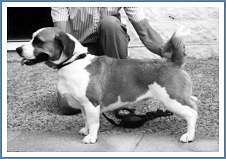 |
|
|
Fig. 1 First generation crossbred, Dolly, one of two with bob-tails used for breeding.
|
|
Fig. 2 Boxer, Steynmere Foreign Service, mate for Dolly. |
Fig. 2 shows the Boxer male to which both bitches were mated. He is my own dog, Steynmere Foreign Service. A total of 16 pups were produced (with remarkable ease) in the two litters and, while several looked very Boxer-like at first, by two to three weeks of age all the Boxer-Corgi differences (long legs vs short legs, longer coat vs shorter coat etc) could be seen to be separating out. No two pups looked alike.
However, one white bitch, Jane, looked very much like a Boxer and remained so through to adulthood. She had the long legs, short coat, and general build of a Boxer, and she had a bob-tail (Fig. 3). Only the head was a somewhat untypical. Although clearly Boxer like it looked "unfinished", shallow and without much depth.
The transformation in one generation (Fig 1. mother and Fig.3 daughter) can only be described as amazing. It suggests that very few genes are responsible for the main features distinguishing the Corgi and Boxer, except for the special Boxer head. The white coat colour,
of course, was Boxer white and resulted from the doubling up on Boxer. |
|
|
| |
Fig. 3 The selected second generation crossbred, Jane, showing bob-tail, Boxer construction and coat, and Boxer white colour. |
The next step was to breed the white bitch to a Boxer male that was strong in type. Avoiding the white, the solid male Boxella's Chief at Zenmaxkay who is of Dutch/German breeding was used. Eight pups were born. All displayed the typical flashy white markings that characterises the show ring Boxer in this country. None were white or solid as expected from a white x solid mating, and 5 of the 8 had bob-tails. One bob-tail was lost as a result of the bitch getting mastitis and contracting kennel cough.
Significantly, all the pups looked like Boxers both in the nest and by 7 weeks of age when Part 3 of the series was written.
Figs 4a-g now illustrate how they looked at 10 months of age. Coming from pet homes, their show poses are not the greatest but nevertheless I think that they all can pass for Boxers. As four of these dogs have bob-tails (Figs 4a, 4e, 4f and 4g) the transfer of the gene from Corgi into Boxer could be said to have just about been achieved. However, the heads still needed improving. The two bitches shown in Figs 4f & 4g, Paddy and Bobby, were initially retained for breeding but due to changes in my home circumstances ultimately had to be homed and bred elsewhere.
|
|
|
| |
4a: Big brindle male, George, with excellent head and mouth, and precision front. A bob-tailed dog of show quality. Used for breeding. |
Figs. 4 Third generation litter at 10 months of age by the Contintal-bred Boxer, Boxella's Chief at Zenmaxkay ex Jane.
|
|
|
4b: Classy red male who regularly goes to Boxer training classes. Docked. |
|
4c: Black brindle bitch. Her conformation was excellent and her head typical, although lacking a little filling under the eyes. Docked. |
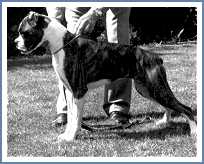 |
|
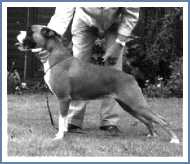 |
4d: Golden brindle bitch. Neatly made but in very light condition. Spayed at an early age. Docked. |
|
4e: Red bitch who as a puppy had sooty patching on her coat. At 10 months her pigmentation was absolutely normal. Typical bob-tail but with a single kink. |
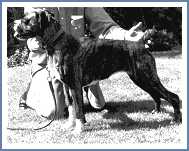 |
|
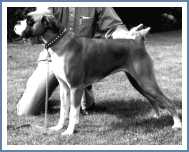 |
4f: Pretty good brindle bitch, Paddy, with a longer, blunt ended bob-tail with single kink. Nicely constructed though plain of head. |
|
4g: Decent red bitch with typical bob-tail. Again plain in head. |
THE FOURTH GENERATION
Breeding dogs over several generations is a slow business, especially through bitches. Therefore, intrigued by the big brindle male, George (Fig 4a), and having one of my Boxer bitches come in season in the Autumn of 1997 when the dog was about old enough to breed, I could not resist the temptation to use him at stud and move through another generation ahead of schedule. The bitch, Steynmere Set The Fashion, suited him well for show points and was especially good in head. Additionally she was strong in breed type.
She whelped eight pups easily but with more to come she stuck and had to have a caesarian. Disaster started here. She had 5 more pups inside her and, although all were delivered alive, two (with normal tails) were tiny and survived only a few days. Worse, the bitch nearly died on the operating table through fluid loss and subsequently had little milk. Three of the 13 (7 with bob-tails) pups were whites and, although they had bob-tails and most promising heads, I opted to put these down to reduce the size of the litter. Even so, with mastitis hitting us again, losses were high and I finished up with only three survivors, two with bob-tails and one with normal tail.
One of the two bob-tails was put in a home where if necessary she could be bred from, but she did not have the best head.
The clear pick of litter was a red with a most pleasing head, but she did not have a bob-tail. Although excluded from the breeding study I have kept in touch and, as evident from her photograph taken recently when she was 8 months of age, she looks pure Boxer and, importantly, her head has remained typical (Fig. 5). The transition back to the Boxer had been made, but unfortunately, without the bob-tail.
I had to try again, and the two bitches, Paddy and Bobby (Figs 4f & 4g), that I had set aside for the purpose were still available. |
|
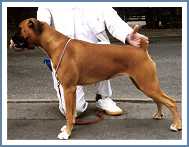 |
| |
Fig. 5 Fourth generation 8 month old bitch by George ex Boxer, Steynmere Set The Fashion. Good enough, but docked.
|
Paddy was mated this Spring to Doreen Greaves' CC winning Barbarossa Matador Magic, a red male of predominantly Continental breeding. Bobby was mated just one week later to the Chippendale's RCC winning Santonoaks Red Hot Prospect of Mylicam, an elegant red male who has a lot of my own (Night Rider) breeding behind him. Underlying the use of two different dogs was the thought of crossing bob-tail animals from the two litters together and avoiding excessive inbreeding.
Paddy whelped easily but produced only three pups, two brindles and one white, all bitches. The two brindles had bob-tails but of a type that I had not seen before. They were not as short as those seen previously, being about one-third of normal length, and tapered neatly to a point. (Fig. 6a)
When I told Peggy Gamble, the pioneer bob-tail Corgi breeder, about these pointed tails she was doubtful about them being bobs. However, they have the filaments of skin at the tips which characterises bob-tails, so I am positive they are bobs; it is just the fleshy pad that is missing. Time will tell if I am right. All three bitches looked like normal Boxers and the heads were better than that of their dam.
Bobby whelped her all red litter by Red Hot Prospect a week later. There were 6 pups. Four of these had typical bob-tails and another had the longer pointed type. The fifth had a normal tail. One of those with a short bob took too long being born and was dead, but the remaining 5 were produced and reared without incident. All appear as standard Boxers although with some variation in the heads.
|
Figs 6a-6d show Bob-tail pups from the two litters at 9-12 weeks of age. One is a heavily boned, short backed lad (Fig. 6b) who has, at this stage, quite a promising head (not evident in the photo). Remarkably he could be thought of as over-typical; Boxer over-typical.
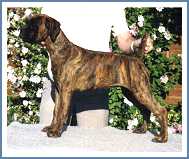
|
|
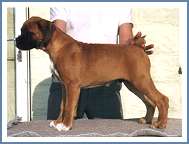
|
6a: One of two brindle bitches, by Barbarossa Matador Magic ex Paddy, with longer, pointed type bob-tails. Heads promise to be better than Mum's but still a little plain. |
|
b. Solid red male, by Santonoaks Red Hot Prospect for Mylicam ex
Bobby. At this stage he exudes Boxer to the point of being over-typical as an adult. |
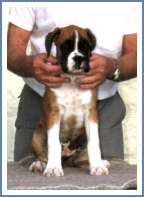 |
|
|
6c: His sister looks quite good but is rather plain in head. |
|
6d: Imposing red brother with longer cast head yet still with Boxer expression. |
Over both litters I had a slight excess of bob-tailed pups over the 50% expected.
A difficulty in presenting these photographs is that I know that everyone in Boxers, myself included, tends to focus upon the show faults of these pups, forgetting the main point is that they look like Boxers, not a mixed breed. The probability that their show faults derive from the Boxer parts of their ancestry, not the Corgi part, is also likely to be missed. However, Boxer type now essentially established and so the final task will be develop the show potential. I do not expect this to be any harder than with purebred Boxers. The unique Boxer head seems to be the major problem but then, in my experience, this is also the case within the breed.
In conclusion, although these pups may not fulfill everyone's idea of show quality Boxers, I think it is fair to claim that the original primary objectives of the project have been achieved; a gene has been successfully transferred from one breed to another, and I have my bob-tail Boxers which do not need to be docked.
WHAT ELSE
Clearly another problem, were the exercise ever to have any practical value, would be the Kennel Club's view on the registration of these dogs. Entry to the KC Breed Register seemed possible under Regulation B.2c of the KC Regulations for Classification and Registration (page 3.21 of the 1997/1998 Yearbook). This concerns dogs of impure, or unverified breeding. I put the case for registration to the Kennel Club together with a copy of my original letter to Martin Sinnatt and a copy of his positive reply. I also provided all the details on the successive generations of crosses, including the photographic evidence, and the fact that blood samples for DNA analysis had been collected at each generation. After much time and no doubt much discussion I was advised that the case had been approved. I then had to register each generation from the first cross through to the last and this I did with the help and advice of Brian Leonard.
The registrations are now with me. They show the early generations as crossbreds and this last, the fourth generation, as Boxers.
So they can now be formally exhibited at shows and in fact the 8 months old bitch illustrated in Fig 4 did compete at a recent Midland Boxer Club event. She did not get placed, but it was a tough class of 20 odd minor puppies. More importantly, however, no one noted anything atypical about her appearance or temperament. She performed in the ring without special attention other than from those in the know. It will be nice if the bob-tail pups from the recent litters can finish up looking as good.
The final step takes us back to genetics. What will happen when bob-tails are intercrossed? As indicated above, I hope to conduct at least one such intercross but, in reality, the answer must come from the bob-tail Corgi or Valhund breeds in which bob-tailed animals are regularly intercrossed. Until I certain that there are no ill effects associated with the bob-tail gene in double dose, I will keep control of all the registrations. For the present every animal I have sold, bob-tailed or otherwise, has either remained registered in my name, or has had its KC registration endorsed, "Progeny not eligible for Registration".
As to the other possibility of introducing the erect ear gene into the Boxer from the Corgi as originally contemplated, I'm afraid this option is no longer available. I have attempted to mate the one bitch retained for the purpose on several occasions but she has always appeared past time when her owners has notified me. Only if the Boxer Breed Council were to be interested in developing erect-eared Boxers would I contemplate starting such a project again.


